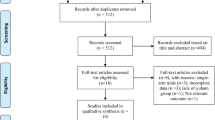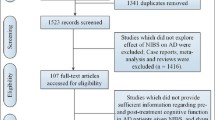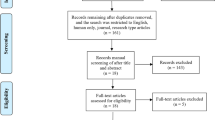Abstract
Objective
High-frequency repetitive transcranial magnetic stimulation (HF-rTMS) is a non-invasive brain stimulation technique used to improve cognitive deficits in patients with Alzheimer’s disease (AD). This systematic review and meta-analysis aimed to evaluate the efficacy of HF-rTMS in improving global cognitive function rehabilitation in elderly patients with mild to moderate AD.
Methods
A detailed literature search of publications using ten databases (Chinese: Wanfang, VIP Periodical, SinoMed, the Chinese National Knowledge Infrastructure; English: PubMed, Embase, OVID, Web of Science, Cochrane Library, and EBSCOhost) was performed to identify English and Chinese language articles published up to December 2022. We only included randomized controlled trials (RCTs) that evaluate the effect of HF-rTMS on elderly patients with mild to moderate AD. The retrieved studies were carefully reviewed, extracted data, and assessed quality.
Results
Seventeen studies, including 1161 elderly patients with mild to moderate AD, were included in this meta-analysis. Compared to the control group, HF-rTMS could increase MMSE (mean difference [MD] = 3.64; 95%CI 1.86–5.42; P < 0.0001), MoCA (MD = 3.69; 95%CI 1.84–5.54; P < 0.0001), P300 amplitude (MD = 1.09; 95%CI 0.45–1.72; P = 0.0008), and total effective rate scores (MD = 3.64; 95% CI 2.14–6.18; P < 0.00001) while decreasing ADAS-Cog (MD = − 3.53; 95%CI − 4.91– − 2.15; P < 0.00001) and P300 latency scores (MD = − 38.32; 95%CI − 72.40– − 4.24; P = 0.03). Our study showed that HF-rTMS could improve the global cognitive function of elderly patients with mild to moderate AD.
Conclusion
HF-rTMS can improve global cognitive function in elderly patients with mild to moderate AD, which is an effective and safe rehabilitation treatment tool for AD patients.
Access this article
We’re sorry, something doesn't seem to be working properly.
Please try refreshing the page. If that doesn't work, please contact support so we can address the problem.











Similar content being viewed by others
References
Kumar A, Sidhu J, Goyal A et al (2022) Alzheimer disease. In: StatPearls. Treasure Island (FL), StatPearls Publishing, pp 1–2
Crous-Bou M, Minguillon C, Gramunt N et al (2017) Alzheimer’s disease prevention: from risk factors to early intervention. Alzheimers Res Ther 9(1):71
The Alzheimer’s Association (2021) 2021 Alzheimer’s disease facts and figures. Alzheimers Dement 17(3):327–406
Se TE, Fauzi A, Tang YQ et al (2021) A review on advances of treatment modalities for Alzheimer’s disease. Life Sci 276:119129
Tang Y, Lutz MW, Xing Y (2019) A systems-based model of Alzheimer’s disease. Alzheimers Dement 15(1):168–171
Zilberzwige-Tal S, Gazit E (2018) Go with the flow-microfluidics approaches for amyloid research. Chem Asian J 13(22):3437–3447
Maccioni RB, Gonzalez A, Andrade V et al (2018) Alzheimer s disease in the perspective of neuroimmunology. Open Neurol J 12:50–56
The Alzheimer’s Association (2022) 2022 Alzheimer’s disease facts and figures. Alzheimers Dement 18(4):700–789
Kropotov JD (2016) Functional neuromarkers for psychiatry. Academic Press, San Diego, pp 281–283
Pulopulos MM, Allaert J, Vanderhasselt MA et al (2022) Effects of HF-rTMS over the left and right DLPFC on proactive and reactive cognitive control. Soc Cogn Affect Neurosci 17(1):109–119
Burke MJ, Fried PJ, Pascual-Leone A (2019) Transcranial magnetic stimulation: neurophysiological and clinical applications. Handb Clin Neurol 163:73–92
Wang X, Mao Z, Ling Z et al (2020) Repetitive transcranial magnetic stimulation for cognitive impairment in Alzheimer’s disease: a meta-analysis of randomized controlled trials. J Neurol 267(3):791–801
Lin Y, Jiang WJ, Shan PY et al (2019) The role of repetitive transcranial magnetic stimulation (rTMS) in the treatment of cognitive impairment in patients with Alzheimer’s disease: a systematic review and meta-analysis. J Neurol Sci 398:184–191
Wang Y, Cheng C, Shen HY et al (2021) Meta-analysis of efficacy of transcranial magnetic stimulation for the treatment of cognitive function and behavioral and psychological symptoms of dementia in patients with Alzheimer’s disease. J Shanghai Jiao Tong University (Medical Science) 41(07):931–941
Budak M, Bayraktaroglu Z, Hanoglu L (2022) The effects of repetitive transcranial magnetic stimulation and aerobic exercise on cognition, balance and functional brain networks in patients with Alzheimer's disease. Cogn Neurodyn 17(1):9–61
Youichi S, Koichi H, Tomoo M et al (2022) Randomized, sham-controlled, clinical trial of repetitive transcranial magnetic stimulation for patients with Alzheimer's dementia in Japan. Front Aging Neurosci 14:993306
Wang ZH, Xu YX, Liu ZP (2021) Analysis of the efficacy and safety of repeated transcranial magnetic stimulation combined with donepezil in the treatment of mild to moderate Alzheimer’s disease. Drug Evaluation 18(10):605–607
Li Jin (2021) Clinical efficacy of extract injection of ginkgo leaf combined with transcranial magnetic stimulation on Alzheimer’s disease. China Modern Doctor 59(12):43–46
Bagattini C, Zanni M, Barocco F et al (2020) Enhancing cognitive training effects in Alzheimer’s disease: rTMS as an add-on treatment. Brain Stimul 13(6):1655–1664
Wang JD, Zhou TT, Chen XQ et al (2019) Clinical effect of Quetiapine combined with cranial magnetic stimulation on psychobehaVioral symptoms of senile dementia. China Med Herald 16(17):46–49
Sun QY (2019) Observation on the treatment of Alzheimer’s disease with repetitive transcranial magnetic stimulation. J Med Aesthetice Cosmetol 28(12):29
Zhang FX (2019) The clinical application of repetitive transcranial magnetic stimulation in Alzheimer’s disease. Huazhong University of Science and Technology, Wuhan, pp 12–61
Ni L, Hua HS, Shao JF et al (2019) Effects of repetitive transcranial magnetic stimulation on cognitive function and psychological symptoms in patients with mild to moderate Alzheimer’s disease. Clin Educ Gen Pract 17(03):216–219
Zhang H, Ji RX, Li J (2019) Treating Alzheimer’s disease using transcranial magnetics stimulation. Chin J Phys Med Rehabil 01:18–22
Li L, Zhou L (2018) The effect of donepezil combined with repetitive transcranial magnetic stimulation on cognitive function and urinary AD7c-NTP levels in patients with AIzheimer’s disease. Pract J Clin Med 15(06):123–126
Zhao JW (2017) Effect of repetitive transcranial magnetic stimulation on cognitive function in patients with Alzheimer disease. Shangdong University, Jinan, pp 18–41
Liu X, Hou QM, Zhao XQ et al (2017) Therapeutic effect of repetitive transcranial magnetic stimulation (10Hz) on BPDS and executive functions in patients with mild to moderate Alzheimer Disease. J North Sichuan Med Coll 32(03):376–379
Liu YH, Wang LN, Bian YH et al (2017) Effect of repetitive transcranial magnetic stimulation with different frequency on cognitive function and behavioral and psychological symptoms in patients with senile dementia. J Int Psychiatr 44(02):263–266
Wu Y, Xu WW, Liu XW et al (2016) Efficacy and safety of olanzapine combined with repetitive transcranial magnetic stimulation in the treatment of behavioral and psychological symptoms of Alzheimer’s disease. Herald Med 35(10):1069–1072
Wu Y, Xu WW, Liu XW et al (2015) Effect of repetitive transcranial magnetic stimulation with different frequency on cognitive function in patients with Alzheimer’s disease. J Pratical Med 31(10):1624–1627
Ahmed MA, Darwish ES, Khedr EM et al (2012) Effects of low versus high frequencies of repetitive transcranial magnetic stimulation on cognitive function and cortical excitability in Alzheimer’s dementia. J Neurol 259(1):83–92
Paitel ER, Samii MR, Nielson KA (2021) A systematic review of cognitive event-related potentials in mild cognitive impairment and Alzheimer’s disease. Behav Brain Res 396:112904
Helfrich RF, Knight RT (2019) Cognitive neurophysiology: event-related potentials. Handb Clin Neurol 160:543–558
Jin Y, Bai X, Jiang B et al (2022) Repetitive transcranial magnetic stimulation induces quantified functional and structural changes in subcortical stroke: a combined arterial spin labeling perfusion and diffusion tensor imaging study. Front Hum Neurosci 16:829688
De-Paula VJ, Radanovic M, Diniz BS et al (2012) Alzheimer’s disease. Subcell Biochem 65:329–352
Tan T, Xie J, Liu T et al (2013) Low-frequency (1 Hz) repetitive transcranial magnetic stimulation (rTMS) reverses Abeta (1–42)-mediated memory deficits in rats. Exp Gerontol 48(8):786–794
Hsu WY, Ku Y, Zanto TP et al (2015) Effects of noninvasive brain stimulation on cognitive function in healthy aging and Alzheimer’s disease: a systematic review and meta-analysis. Neurobiol Aging 36(8):2348–2359
Qin Y, Zhang F, Zhang M et al (2022) Effects of repetitive transcranial magnetic stimulation combined with cognitive training on resting-state brain activity in Alzheimer’s disease. Neuroradiol J 35(5):566–572
Di Lazzaro V, Bella R, Benussi A et al (2021) Diagnostic contribution and therapeutic perspectives of transcranial magnetic stimulation in dementia. Clin Neurophysiol 132(10):2568–2607
Li X, Qi G, Yu C et al (2021) Cortical plasticity is correlated with cognitive improvement in Alzheimer’s disease patients after rTMS treatment. Brain Stimul 14(3):503–510
Koch G, Casula EP, Bonni S et al (2022) Precuneus magnetic stimulation for Alzheimer’s disease: a randomized, sham-controlled trial. Brain 145(11):3776–3786
Menardi A, Rossi S, Koch G et al (2022) Toward noninvasive brain stimulation 2.0 in Alzheimer’s disease. Ageing Res Rev 75:101555
Deardorff WJ, Grossberg GT (2019) Behavioral and psychological symptoms in Alzheimer’s dementia and vascular dementia. Handb Clin Neurol 165:5–32
Jiang W, Wu Z, Wen L et al (2022) The efficacy of high- or low-frequency transcranial magnetic stimulation in Alzheimer’s disease patients with behavioral and psychological symptoms of dementia. Adv Ther 39(1):286–295
Shang YQ, Xie J, Peng W et al (2018) Network-wise cerebral blood flow redistribution after 20 Hz rTMS on left dorso-lateral prefrontal cortex. Eur J Radiol 101:144–148
Nguyen JP, Suarez A, Kemoun G et al (2017) Repetitive transcranial magnetic stimulation combined with cognitive training for the treatment of Alzheimer’s disease. Neurophysiol Clin 47(1):47–53
Hiser J, Koenigs M (2018) The multifaceted role of the ventromedial prefrontal cortex in emotion, decision making, social cognition, and psychopathology. Biol Psychiatry 83(8):638–647
Jung J, Lambon RM, Jackson RL (2022) Subregions of DLPFC display graded yet distinct structural and functional connectivity. J Neurosci 42(15):3241–3252
Li X, Du L, Sahlem GL et al (2017) Repetitive transcranial magnetic stimulation (rTMS) of the dorsolateral prefrontal cortex reduces resting-state insula activity and modulates functional connectivity of the orbitofrontal cortex in cigarette smokers. Drug Alcohol Depend 174:98–105
Gamond L, Ferrari C, La Rocca S et al (2017) Dorsomedial prefrontal cortex and cerebellar contribution to in-group attitudes: a transcranial magnetic stimulation study. Eur J Neurosci 45(7):932–939
Chen Y, Cha YH, Li C et al (2019) Multimodal imaging of repetitive transcranial magnetic stimulation effect on brain network: a combined electroencephalogram and functional magnetic resonance imaging study. Brain Connect 9(4):311–321
Anderkova L, Rektorova I (2014) Cognitive effects of repetitive transcranial magnetic stimulation in patients with neurodegenerative diseases-clinician’s perspective. J Neurol Sci 339(1–2):15–25
Acknowledgements
We thank Medjaden Inc for the scientific editing of this manuscript.
Funding
This study was supported by The open subject of nursing discipline in Fujian University of Traditional Chinese Medicine in 2022 (XHL2022003).
Author information
Authors and Affiliations
Contributions
Huoqin Xiu, Fang Liu and Yufei Hou conceived the review. Huoqin Xiu and Yufei Hou wrote the manuscript. Yufei Hou, Xin Chen, and Fang Liu performed the data extraction. Huoqin Xiu, Fang Liu and Shuzhen Tu participated in the data analysis. The final version of the manuscript before submission has been approved by all authors.
Corresponding author
Ethics declarations
Conflict of interest
The authors declare no competing interests.
Ethical approval
None.
Statement of human and animal rights
This article does not contain any studies with animals performed by any of the authors.
Additional information
Publisher's Note
Springer Nature remains neutral with regard to jurisdictional claims in published maps and institutional affiliations.
Rights and permissions
Springer Nature or its licensor (e.g. a society or other partner) holds exclusive rights to this article under a publishing agreement with the author(s) or other rightsholder(s); author self-archiving of the accepted manuscript version of this article is solely governed by the terms of such publishing agreement and applicable law.
About this article
Cite this article
Xiu, H., Liu, F., Hou, Y. et al. High-frequency repetitive transcranial magnetic stimulation (HF-rTMS) on global cognitive function of elderly in mild to moderate Alzheimer’s disease: a systematic review and meta-analysis. Neurol Sci 45, 13–25 (2024). https://doi.org/10.1007/s10072-023-07072-5
Received:
Accepted:
Published:
Issue Date:
DOI: https://doi.org/10.1007/s10072-023-07072-5




